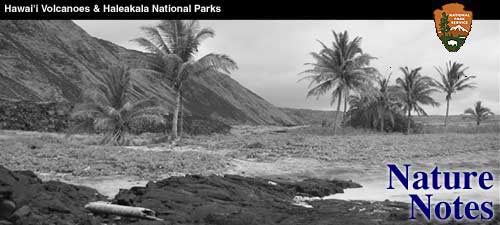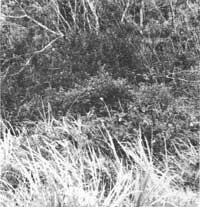

|
|
HAWAII NATURE NOTES
EPIPHYTES OR AIR PLANTS Epiphyte is from the Greek words meaning "upon plants." Many plants normally growing on the ground may be seen growing on trees in Hawaii. Plants adapted to this form of life are not parasitic, and derive much of their moisture from the air. One of the most common epiphytic plants found in the park is the painiu. Mosses, lichens, and orchids also grow in this manner. Of the last, at least two native species are found in the Kilauea section of the park, but they are so rare and inconspicuous that they are seldom seen by the visitor. Existence as an epiphyte is in many respects more precarious than as a terrestrial plant because of dry seasons when moisture cannot be obtained from the air. At such times the plant must either survive on stored moisture or become dormant. Epiphytes may be seen commonly in the vicinity of the Thurston Lava Tube and throughout the fern jungle. Trees such as the pilo and ohia commonly begin their lives as epiphytes, often upon the trunks of tree ferns. The name "mother of ohia" has been given to these ferns because of the large numbers of ohias seen growing upon their trunks. This often leads to the eventual death of the fern from being encircled and choked by the ohia roots as the tree reaches maturity. Near the entrance to the Thurston Lava Tube you can see a large, fallen ohia which apparently lodged as a seed on a tree fern, grew to a large size, died, and when it fell carried down the old fern which "mothered" it.

Undesirable as exotic plants are in a national park, where the primary endeavor is to keep all things—plant, animal, and mineral—in their original condition, it is useless not to recognize their presence in Hawaii National Park. Many of them are well-established and will probably never be entirely removed. Unfortunately, some are among the most attractive plants and the first to catch your eye. Also unfortunate is the fact that when plants are introduced into an area they often spread unchecked because of the absence of natural enemies. Man's disturbance of the ground cover by activities such as road building and clearing for agriculture often permits non-native plants to become established. Compare the ugly jungle of Tibouchina, Tritonia, guava and Eucalyptus below with the unspoiled fern jungle on page 4. Descriptions of several common exotics follow. |
| <<< Previous | > Cover < | Next >>> |
nature_notes/havo/vol4-1h.htm
24-Mar-2006